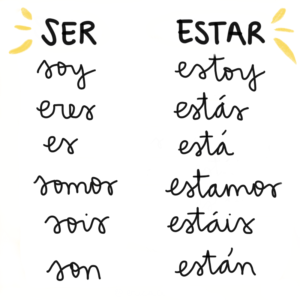
POR vs PARA ⎮Grammar⎮Spanish lesson
Hay mucha confusión con estas preposiciones, incluso los alumnos avanzados a veces se equivocan. Así que PARA aprender bien español, necesitas esta clase.
¡Empezamos!
La preposición POR
Causa
Uno de los usos más comunes. El motivo, la razón, “debido a”, “a causa de”:
- No puedo dormir por el calor
- Me han despedido por tu culpa
- Miguel no tiene trabajo por la crisis económica
Partes del día
- Por la mañana, hago deporte
- Por la tarde, trabajo en un hospital
- Por la noche, salgo con mis amigos
Lugar o tiempo aproximado
Malasaña es un barrio del centro de Madrid. Si yo digo algo como:
- Esta tienda está por Malasaña
- Vivo por el centro
Significa que no sé, no recuerdo ( o no quiero decir) la dirección, el lugar exacto. La información que doy es que está “más o menos en esa zona”.
- Tengo vacaciones por Navidad
Una vez más no puedo, no recuerdo o no me apetece decir la fecha exacta.
Medio
El modo que usas para comunicarte, ” a través de”, “por medio de “:
- Hablo con mis estudiantes por Instagram
- Si quieres clases de español online conmigo, mejor escríbeme por correo electrónico
- Compro mucho por Internet
Intercambio, compra, precio
- Compré este libro por 7€
- Te cambio mi coche por tu bicicleta
Frases pasivas
En este tipo de frases también usamos por. Así, en lugar de decir:
- Los españoles inventaron la fregona, puedo decir:
- La fregona fue inventada por los españoles
Hablando de fregonas y de fregar, te he preparado una clase sobre las tareas domésticas y los verbos irregulares. (P.ej: el verbo fregar e/ie).
Lugar que se atraviesa para llegar a otro destino
Vamos a imaginar que cogemos un tren en Madrid, con destino Barcelona.
Si yo digo:
- Este tren pasa por Lleida
Lo que quiero explicar es que durante el trayecto el tren va a pasar por esta ciudad.
La preposición PARA
Finalidad /objetivo
- Hago vídeos en Youtube para enseñar español a todo el mundo gratis
- Miro vídeo en versión original (V.O) para mejorar mi inglés
- Me ducho todos los días para estar limpia
Opinión
Lo podemos sustituir por ” en mi opinión”, “creo que”, “yo pienso que”:
- Para mí, la diferencia entre ser y estar es un poco difícil
- Para mí, comer sano es muy importante
Destino
- Voy para casa
- Este tren va para Málaga
Con esta preposición estamos indicando el destino final
Fecha límite
Usamos para cuando tenemos que hacer la entrega de algún trabajo o proyecto en una fecha determinada. Se suele usar en contextos académicos y laborales.
- Los deberes son para el próximo martes
- Este proyecto tiene que estar para mañana
Considerando que
Para mí, este uso es un poco dificultoso para los extranjeros pero muy fácil de aprender. En inglés sería: to be a stranger, to speak Spanish pretty well.
- Para ser extranjero hablas muy bien español
Destinatario
- Este vídeo sobre las 10 palabras que necesitas conocer para hablar como un nativo es para ti
- Este regalo es para ti
Video lesson about POR vs PARA
FREE GIFT: interactive activity + visual summary
Do you want to practice more? Ok, so… Leave me a comment below using POR or PARA. I will correct you!

Did you find the lesson useful? Print it, save it as PDF or even email to a friend. You know what they say, SHARING IS CARING so.. .if you know about someone learning Spanish, share the lesson in your social media! It’ll mean the world to me. Thanks! ♥︎




